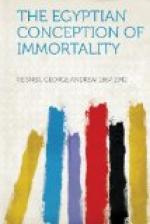In many offering chambers there is a small hole in the wall, either in the offering niche or in another place. If this hole be properly lighted and the space beyond has not been changed by decay or violation, the light falls on the face of a statue of the dead looking forth to the world of the living. For behind the wall is another chamber, closed except for this small hole. This hidden chamber contains statues of the dead often accompanied by statues of his family and his servants. These statues of the dead are labeled with his name, and are said to be the abode of his spirit, his ka, as the Egyptians called it. Moreover, all the offering formulas named the ka as the recipient of the food and drink. The duplicate spirit of the man is his ka. In these statues we have, then, a simulacrum of the man provided for use of his ka—perhaps to assist the ka to the persistence of his earthly form, and to the remembrance of his name. But what were the uses of the subsidiary statues? What spirit resided in them? The man’s son in his turn died, and a similar room was made for him with his statue and his subsidiary statues. Did his ka live both in the statue placed with his father’s statue and also in the statue in his own grave? We have no answer. Probably the Egyptian mind never formulated the difficulty.
But the new idea is clearly expressed. It is no longer necessary to fill the burial chamber with a mass of household furniture for the use of the dead. All these things can be carved on the wall of the burial chamber and so made effective for his use. It was in any case necessary to supply his food by means of the offerings, and it was quite as easy to supply all his other necessities in the same way. In other words, there is a distinct growth in the use of magic to benefit the dead. At the same time, we find the growth of the custom of supplying a special abode for the ka—a simulacrum of the man, which assisted the ka to retain the form of the living man and to remember his identity.
The tendency of this period is then to place a greater dependence on magic than on food, drink, and grave furniture. It is, therefore, not surprising to find introduced, for the first time, the use of magical texts in the burial chamber,—the so-called Pyramid Texts. In the burial chamber in the pyramid of Unas, last king of the Fifth Dynasty, and in the pyramids of the kings of the Sixth Dynasty, the walls are covered with long magical texts or chapters—the




